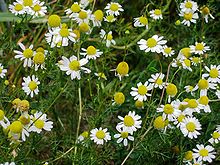Azulene
| Structural formula | ||||||||||||||||
|---|---|---|---|---|---|---|---|---|---|---|---|---|---|---|---|---|

|
||||||||||||||||
| General | ||||||||||||||||
| Surname | Azulene | |||||||||||||||
| other names |
|
|||||||||||||||
| Molecular formula | C 10 H 8 | |||||||||||||||
| Brief description |
intense blue odorless crystals |
|||||||||||||||
| External identifiers / databases | ||||||||||||||||
|
||||||||||||||||
| properties | ||||||||||||||||
| Molar mass | 128.17 g mol −1 | |||||||||||||||
| Physical state |
firmly |
|||||||||||||||
| Melting point |
99 ° C |
|||||||||||||||
| boiling point |
242 ° C |
|||||||||||||||
| solubility |
|
|||||||||||||||
| Dipole moment | ||||||||||||||||
| safety instructions | ||||||||||||||||
|
||||||||||||||||
| As far as possible and customary, SI units are used. Unless otherwise noted, the data given apply to standard conditions . | ||||||||||||||||
Azulene (from French azure "blue") or cyclopentacycloheptene is a blue crystalline aromatic hydrocarbon . It is an isomer of naphthalene and, for a hydrocarbon, has a remarkably high dipole moment .
history
As early as the 15th century, steam distillation of chamomile made it possible to obtain a deep blue essential oil that has an anti-inflammatory effect. It was not until 1915 that Alfred E. Sherndal isolated the azulene as the carrier of this blue color through the action of acid. However, the tricyclic ( triple ring ) aromatic structural formula established by Sherndal turned out to be incorrect. In 1926, Leopold Ružička found the correct sum formula. It was not until 1936 that Alexander Pfau and Placidius A. Plattner were able to clarify the establishment of this connection.
In 1941, Plattner set up empirical rules for predicting the color shade depending on the substitution pattern . In 1955, azul systems became more accessible through the Ziegler-Hafner synthesis developed by Klaus Hafner and Karl Ziegler . Nevertheless, only 60 connections with an azul system were known in the mid-1970s. In the mid-1990s, this number doubled through the synthesis of 50 azulene carboxylic acid esters . Incorrectly determined structures could be corrected by means of NMR spectroscopy .
properties
Physical Properties
Azulene is insoluble in water; in organic solvents it dissolves with a deep blue color. It is one of the few known molecules that do not obey the Kasha rule , ie show fluorescence from the S 2 state. The solid is irritating .
Chemical properties

Hydrocarbons that are formally derived from azulene are called azulenes ; they are colored blue to purple. An example of this is the blue 6- tert- butylazulene . The color can be explained by a charge transfer between the two rings. Azulene is metastable . After years of storage, it isomerizes to naphthalene .
synthesis
Azulene can be synthesized, for example, by means of the Hafner synthesis in a one-pot process. It proceeds via the starting materials 2,4-dinitrochlorobenzene, pyridine, cyclopentadiene and dimethylamine.
Occurrence

The best-known natural azulene compound, "Proazulen C" ( Matricin ), occurs in chamomile and changes to chamazulene (1,4-dimethyl-7-ethylazulene) at 80 to 90 ° C. These azulenes are dehydrated sesquiterpene derivatives .
use
Azulene derivatives from natural sources are often used in cosmetic products.
Individual evidence
- ↑ entry to azulenes in CosIng database of the European Commission, accessed on February 25 2020th
- ↑ a b c data sheet Azulene, 99% at AlfaAesar, accessed on June 21, 2019 ( PDF )(JavaScript required) .
- ↑ a b Entry on Azulene. In: Römpp Online . Georg Thieme Verlag, accessed on February 14, 2019.
- ↑ a b c data sheet Azulene at Sigma-Aldrich , accessed on February 14, 2019 ( PDF ).
- ↑ David R. Lide (Ed.): CRC Handbook of Chemistry and Physics . 90th edition. (Internet version: 2010), CRC Press / Taylor and Francis, Boca Raton, FL, Dipole Moments, pp. 9-52.
- ↑ See Septimus Piesse : On the Coloring Principle of Volatile Oils . In: Chemical News . No. 8 , 1863, p. 245 ( online [accessed March 2, 2015]).
- ^ Karl Ziegler, Klaus Hafner: A rational synthesis of the azulene. In: Angewandte Chemie. 67, 1955, pp. 301-301, doi : 10.1002 / anie.19550671103 .
- ↑ Dieter Wöhrle, Michael W. Tausch, Wolf-Dieter Stohrer: Photochemistry: Concepts, Methods, Experiments - Wöhrle - Wiley Online Library . Wiley-VCH, 1998, ISBN 978-3-527-29545-6 , pp. 66 .
- ↑ K. Hafner, H. Kaiser: 4,6,8-Trimethylazulene In: Organic Syntheses . 44, 1964, p. 94, doi : 10.15227 / orgsyn.044.0094 ; Coll. Vol. 5, 1973, p. 1088 ( PDF ).
- ↑ LF Tietze, Th. Eicher: reactions and syntheses . 2nd Edition. Georg Thieme Verlag, Stuttgart 1991, ISBN 3-13-612302-6 , p. 304 .
